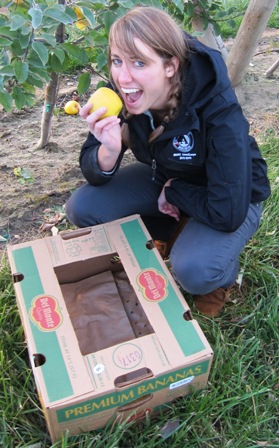Gleaning Model

Walla Walla Community Harvest gleans produce from commercial farms and orchards, farmers markets and residential gardens and trees. Most of the gleaned produce is within Walla Walla, Columbia and Umatilla counties. The process of gathering information and planning is essentially the same for large and small scale gleaning events but varies in volunteer help and transportation needs.
WWCH rarely turns down a gleaning opportunity and tries to schedule events when it is most convenient for the donor and volunteers, and the resulting produce can be distributed quickly. Due to time sensitivity, weather, and market changes, several gleans were scheduled with short notice. When possible, gleans were scheduled on the weekend or evenings and within 3-4 days notice.
With over 42 different crops being grown in the valley, WWCH was able to glean a large variety of produce. The harvest season usually runs from May-November. A small handful of growers have the ability to provide fresh produce throughout the winter using hoop and greenhouses. Walla Walla also exclusively grows the delicious Walla Walla Sweet Onion, an opportunity which we were able to take advantage of and glean several “imperfect” onions!
Currently, the VISTA volunteer manages all aspects of the gleaning program and attends every gleaning event. WWCH is looking to increase volunteer participation and ownership of the program along with some grant funding to help transition the project into a paid position and away from being run by a VISTA volunteer.
What to Ask Growers
-
What is the crop and how much of it are you looking to donate?
-
Do we need to harvest it or has it already been harvested?
-
When would be a good time to schedule a glean?
-
Will you provide any tools?
-
Do you know approximately how many volunteers we will need?
-
Where should we park?
-
Will you be there to show/instruct gleaners?
-
Are you comfortable with volunteers using ladders or knives if appropriate?
-
Are you OK if children, with parental supervision, attend the glean?
Next, coordinate with your distribution center or food banks to make sure they can store or accept the fresh produce that is coming in. Tell them the type of produce and a ballpark figure of how much you think you will be harvesting and bringing in.
Getting your volunteers organized
Send an email or call your volunteers with information about the upcoming glean. Tell them what you will be gleaning, if they need to bring anything special, where to park, if facilities will be available, and if children are allowed. If the farm is farther away, suggest meeting at a central location and carpooling. Ask volunteers to RSVP so you have an idea of how many people are planning showing up.
Transportation
Make sure to bring enough asparagus lugs, banana boxes, crates, bags or whatever you will be using to put your gleaned produce in. If the glean is medium sized, WWCH uses the BMAC pick-up truck to haul boxes and bins. For bigger and more hardy produce gleans, WWCH takes large bins out to the farm and hauls them back in larger trucks. Depending on the product and distribution, WWCH boxes it at the food bank or leaves it in the bins. If company vehicles are not available, ask your volunteers if they can help haul some boxed produce to the food bank.
Collecting Data
It is important to track produce donations, volunteers and hours. An Excel spreadsheet is an easy way to calculate and organize data. If possible, ask your local food banks to track individual donations of fresh produce also. This data is important for future funding, grant applications and to track successes.


